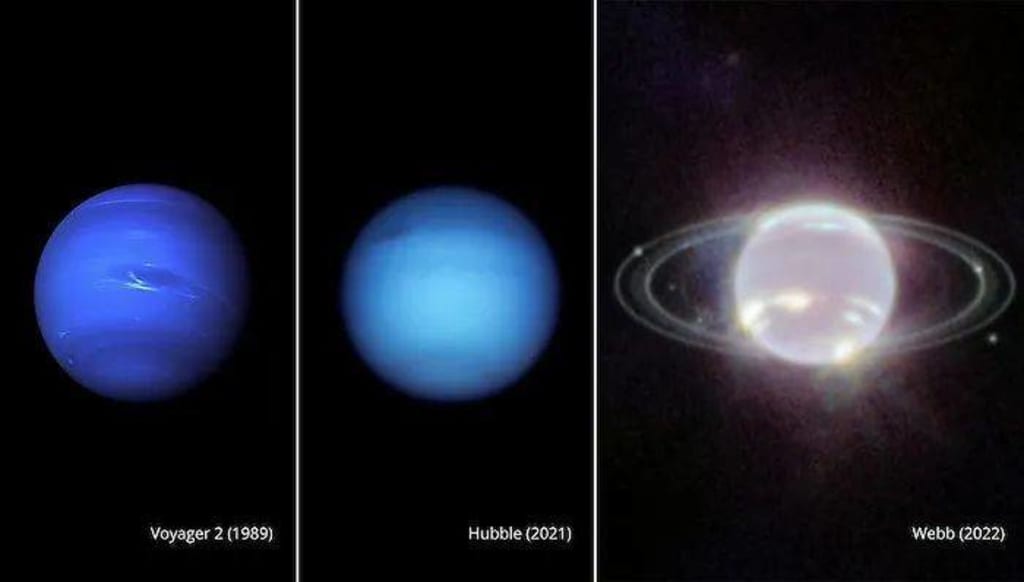
The James Webb Space Telescope has turned its sights from the depths of the universe back to the solar system, using the latest technology to capture details of Neptune and its rings. This is the clearest image of the subject in more than 30 years.
The composite image provided by NASA shows three images of Neptune side-by-side. From left to right are photos of Neptune taken by Voyager 2 in 1989, Hubble in 2021, and Webb in 2022
On September 21, NASA released these images, which clearly show Neptune's beautiful rings. The Webb telescope took only a few minutes to image Neptune up close, and another 20 minutes to take a broader view. Through this view, the imaging also revealed the myriad of cosmic galaxies in the background.
Neptune is the most distant planet in our solar system and, along with Uranus, is known as an "ice giant" whose interior is made up of more dense chemicals than the gas giants Jupiter and Saturn. Neptune is so far from the sun that its midday brightness is like a dim twilight on Earth, NASA said.
NASA's Voyager 2 probe flew past Neptune on its way out of the solar system in 1989, and no spacecraft has visited it since. This glimpse 30 years ago whetted the appetite of astronomers eager to learn more about this icy giant.

In previous images taken by the Hubble Space Telescope, Neptune appeared dark blue because of the methane in its atmosphere. However, the near-infrared wavelengths captured by Webb's primary imager, NIRCam, show the planet to be grayish-white, with icy clouds flowing over its surface.
Methane ice clouds on Neptune's surface rise high into its sky and can last for days. Patrick Irwin, a planetary physicist at Oxford University, said no one really knows what these things are so far, and look a bit like cirrus clouds on Earth. And future observations by the Webb telescope could reveal how they form and what they're made of.
Mark McCaughrean, the senior science advisor at the European Space Agency, said Webb's unprecedented infrared imaging capabilities offer new perspectives on observing Neptune's atmosphere. The Webb telescope removes all the glare and background, supporting scientists to start sorting out the composition of Neptune's atmosphere, "something that would have been unthinkable five years ago."
This latest Webb photograph is also the first time that Neptune's rings have been seen through an infrared view. It's been three years since we last saw Neptune's rings, and this is the first time we've seen them in infrared, Heidi Hammel, an interdisciplinary scientist with the Webb project, said in a statement.
Klaus Pontoppidan, a Weber project scientist at the Space Telescope Science Institute, said what stands out in Weber's view are Neptune's rings, which can be seen encircling Neptune at a slight tilt given its orientation to Earth. The new images could reveal the size and composition of the rings, which could be ice and other debris. Webb will allow astronomers to measure the reflectivity of the rings, providing an unparalleled opportunity to gain insight into the distance it.
In addition, the latest photos have increased astronomers' attention to Neptune's north pole, which NASA said in a statement shows an "intriguing brightness" near the top of Neptune. Because Neptune is the farthest planet from the sun, taking 164 years to orbit the sun, and it is tilted away from Earth, astronomers have not had the opportunity to take a closer look at its north pole so far.
In addition to this, Webb has discovered seven of Neptune's 14 known moons. In a zoomed-in image, there is a faint, very bright spiky object in the upper left of Neptune, one of Neptune's largest moons (Triton) that is brighter than Neptune itself. Scientists speculate that it was captured by Neptune's gravity in the early solar system.
Future Webb observations should uncover the composition of Triton's surface and may reveal changes in geological activity. Triton is a geologically active world, and when Voyager 2 flew by 30 years ago, it saw eruptions of cryovolcanoes, Webb project scientist Hammel said. As a result, the chemical composition of its surface may have changed over time.
Mark McCaughrean of the European Space Agency noted that the significance of observing ice giants like Neptune is that it ensures our ability to focus on other ice giants. Astronomers are searching the universe for other planets similar to Earth, and in the process, they have found that ice giants like Neptune and Uranus are the most common in the galaxy.
Webb, the most powerful space telescope ever built, was first launched last December and has been releasing deep-sky photos since July of this year, already providing an unprecedented amount of data. Studies based on Webb's observations of Neptune and Triton are expected to take place next year, which scientists hope will herald the dawn of a new era of discovery.
About the Creator
Monu Ella
And I know it's long gone and there was nothing else I could do






Comments
There are no comments for this story
Be the first to respond and start the conversation.